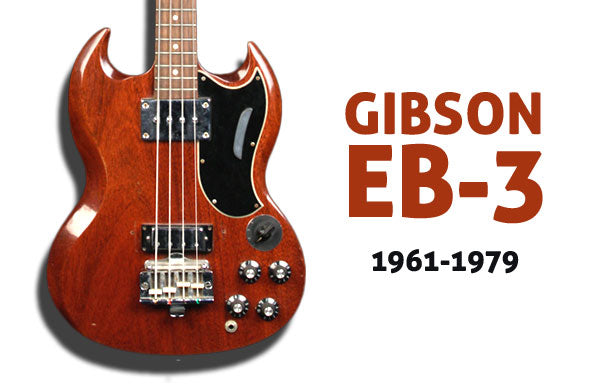AF110: Gibson EB-3 Bass Guitar 1961-1979

Editor’s Note: Longtime readers of 20th Century Guitar will recognize the nom de plume G7 and his column “Anything For $1.10”. This infamous, hilarious, and enigmatic writer makes his return to writing about all things musical for themusiczoo.com. G7 will be a regular contributor to these pages and we are glad to have him.
Anything For $1.10: Gibson EB-3 1961-1979 by G7
What is the shortest book in history after Famous Living Near Sighted Bull Fighters-Vol. I? That would have to be Famous Gibson Bass Players. This would include Jack Bruce, Andy Frazier, Felix Pappalardi, Nikki Six, John Entwhistle (sometimes) and that guy from Nirvana. Oh yeah – and every bass player from the first British Invasion. Poor Gibson! For all their success with six strings, they could never quite come up with a bass guitar that the playing public embraced with any fervor. How come?
In the 50’s and early 60’s Gibson’s bass formula always revolved around a short (30 1/2 inch) scale – thud – and a really loud pickup (or two). Even as the venerable Fender Precision became the generic staple for bottom dwellers, Gibson would not stray from their formula until 1963 with the introduction of the Thunderbird basses with new pickups and a longer Fender-like scale length.
Among Gibson’s earlier basses, the EB-3 was the most versatile. It was introduced in 1961 as an upscale version of the recently revamped single pickup EB-O. 1961 was the year Gibson switched most of their solid body instruments, including basses, to the new “S.G.” body style. The EB-3 sported a mini humbucker in the bridge position and like the EB-O and EB-2, a truly massive neck humbucker. Pickup selection was accomplished with a new style four position rotary control. The original bridge was a variation of the wraparound type used on Les Paul Junior and Special guitars. It was changed within a few years to a tunematic type which, given the difficulties of tuning on a short scale, was a definite improvement.
Now- about that sound. On the positive side, these basses can come remarkably close to the sound of an amplified upright bass. The neck pickup tone is big, round and low. You can get a good sense of it on Black Dub’s debut album, Daniel Lanois’ new group. The down side is that’s about all they do. Power seems to be their foremost feature. The EB-3 can be tamed somewhat by blending in the bridge pickup. It is interesting to note that when these instruments were first produced nobody, including Gibson, made an amp that could handle their output above volume “1”. Those neck pickups could make sludge out of just about any amp made at the time. Amp technology had improved sufficiently enough by the end of the 60’s that basses like the EB-3 could be used more safely. It was still sludge but at least it didn’t fry the speakers with such alarming regularity. It required a great deal of musical panache to choose one of these monsters to hold down the bottom end. Listen to any of the live Cream or Mountain albums and you will get an idea of how an “EB” can sound in truly capable hands. Gibson basses seem to help fill out the sound of small combos. Perhaps that is why many alternative groups are turning to Gibson basses, or maybe it’s just Fender backlash.
No matter. If you want more thump from your stump, try a Gibson EB-3.













